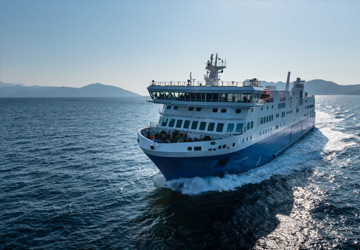
-
Recent Searches
Recent Searches
- Travel Alerts
- My Account
- Customer Service
-
United Kingdom
Mljet to Korcula Ferry
The Mljet Korcula ferry route connects Croatia with Korcula Island. Currently there is just the 1 ferry company operating this ferry service, TP Line. The crossing operates up to 7 times each week with sailing durations from around 40 minutes.
Mljet Korcula sailing durations and frequency may vary from season to season so we’d advise doing a live check to get the most up to date information.
Mljet Guide
Located in the Dalmatia region of Croatia, and the most southerly and easterly of the larger Adriatic islands, is the island of Mljet. It is located to the south of the Peljesac Peninsular and is roughly 25 km long and around 3 km wide, on average. The island's volcanic origin is clear to see with its many gorges and chasms. The north western part of the island as an internal sea that has been a national park since 1960. The National Park also includes Veliko jezero, Malo jezero, Soline Bay and a sea belt that is 500m wide from the most prominent cape of Mljet covering an area of around 55 sq. km. The central parts of the park are Veliko jezero with the Isle of St. Mary, Malo jezero and the villages of Govedari, Polace and Pomena.
The main port on the Island is Sobra, located on the island's eastern coast and connects the island by ferry to Dubrovnik and Korcula. There is also a daily car ferry service from Dubrovnik to Sobra.
Korcula Guide
The Croatian island of Korcula is one of the greenest islands in the Adriatic sea and is also one of the most popular destinations in Croatia. The island's name was originally Korkyra Melaina (Black Corfu) and was given to it by the Greeks who named many of the Croatian islands. The name was perhaps given to the island in reference to its densely wooded terrain. The island has a rich cultural and artistic heritage and is also a nature lover's paradise with many tucked away beaches and coves, uninhabited islands and stunning views. The island's main town is also named Korcula and is a typical medieval walled Dalmatian city, with its round towers and red roofed houses.
The town's Old Town is a walled medieval city that is situated on an oval-shaped piece of land that sticks out into the Peljesac Channel. The Old Town itself is characterised by narrow streets that all stem of the town's main street. The fish bone shape was used in Korcula Old Town design to reduce effects of wind and sun and to provide its inhabitants with sheltered and comfortable accommodation. The architecture in the Old Town is mainly influenced by Venetian Renaissance, although there are also some fine examples of 1930's architecture.



